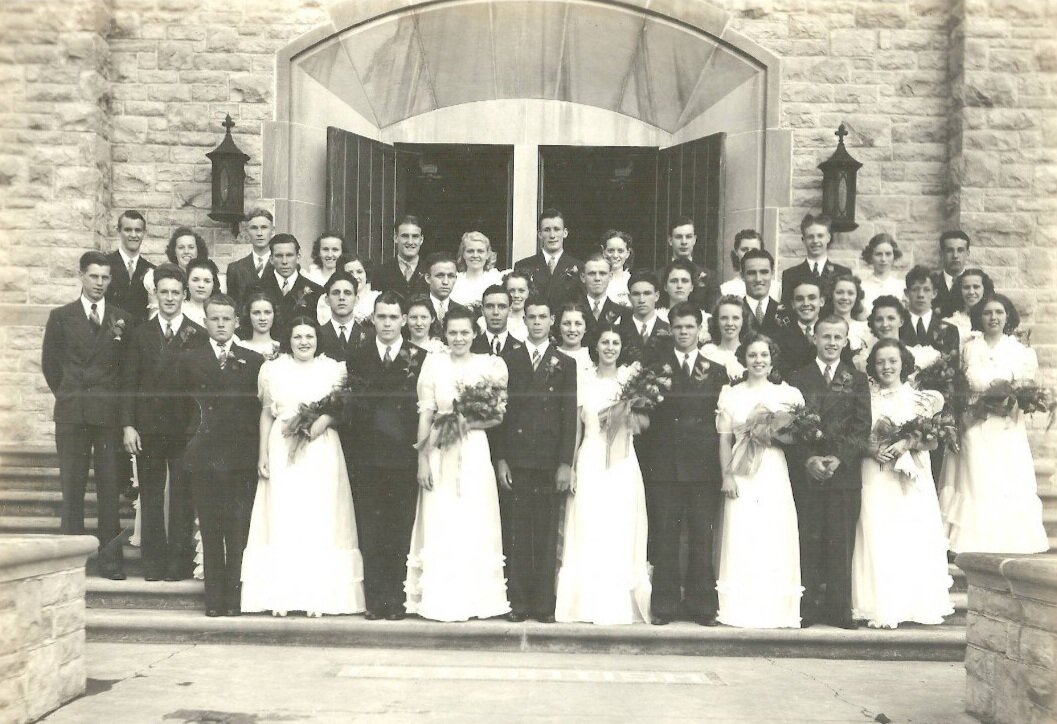By Emily Rinaman, Technical Services Librarian
Facebook walls abound with videos recorded by fascinated youngsters of older couples owning the dance floor. But when you think about it, this really isn’t a phenomenon. Dancing was a very popular form of social gathering for many of the older generations that crown our population. Before texting, skyping, and all other manners of virtual conversing, people had to actually step out of their houses to have a connection to others. Dances were a fun, relaxing way of meeting new people and making new memories with one’s friends and family.
An unknown couple enjoy their 1974 Prom at Columbian (The theme was “Down By the Old Millstream.”)
Prom remains a rite of passage into emerging adulthood for the majority of teenagers but it has greatly evolved from its somewhat meager beginnings. While teenage couples and groups go all out on the big awaited weekend by scheduling up-dos at the hairdresser, coordinating tuxedo vest and fancy dress colors with corsages and boutonnieres, renting limos, and making reservations at local restaurants, 70 years ago Prom as its known today was simply the last dance of the school year after many other formals and holiday dances had occurred throughout the months.
Many of the older yearbooks in the Seneca County Digital Library mention sophomore proms. Prom was not always a long-awaited accumulation of sometimes teenage anxiety for one of the biggest days prior to graduation. Wikipedia explains that until the 1940s, prom was just a banquet held in the gymnasium where high school seniors simply wore their “Sunday best.” It wasn’t until the 1950s that proms became fancier, branched out to other locations beyond the school and had their own dedicated spreads in the yearbooks.
Before there was the Charleston and the jitterbug or slow dancing at the Prom, members of high society held dances in double parlors or ballrooms that were part of their houses’ floor plans (often the top floor). Teenage girls “of age” would “debut” themselves and carry a card with the schedule of dances for the evening. Men would vie to gain a spot (or more) on the card and the young women would secretly hope their cards were not left empty. So, even then, there was a sense of embarrassment if one was not popular.
A group of young adults from the Junior Home gather for a formal in 1939.
The History of the Tiffin Fire Department has an image of one such card that lists 24 dances and an intermission halfway through. The 1881 Fire/Police Ball included 8 Quadrilles, 5 Waltzes, 5 Schottisches, a Virginia Reel, a Polka, a Monnie Musk, a Varouvienne, a Fireman’s Dance and a Wild Irishman to end the night (see the end of the blog for definitions of each type of dance).
As time wore on, perceptions of the coming-of-age (or “bildungsroman…” as a little trivia tidbit for you, as it’s officially referred to when a librarian catalogs a novel under this subject) period of a young adult’s life changed. Once the Victorian era gave way to the flappers, females had a little bit more freedom with the social morés of dancing. An anonymous author nicknamed “Not a Wallflower” writes this in a January 1939 article of Tiffin University’s newspaper, Tystenac:
“There were the romantic dances to which a young gentlemen escorted
his lady fair and was assured of two wonderful moments with the girl of his
heart, the first and last dances. Well, they did have good times by seeing
just how many dancing partners they could add to their lists and by thus
exhibiting a spirit of friendship and gaiety that seems to be quite out-moded
on the modern dance floor. But why can't we, too, be friendly and help
others to have a good time? After all, did you ever consider your partner's
point of view? He or she may be a little tired of doing the same steps and
chattering to the same ears all evening. A change will do you both good.
When our Valentine dance comes around, we'll have a good chance to
prove that we are not dancing with the same person all evening just because
we have to. So let's "change partners—and dance!" It will be fun.”
Around this time Tiffin University also had “hard-times dances,” which became popular after the Stock Market Crash of 1929. These were a scaled down version of the former Victorian ballroom dances, except the girls wore simple dresses because they couldn’t afford expensive fabrics.
Works cited:
Between the Eighties, Tiffin, Ohio 1880-1980. Myron Barnes, 1982. https://www.ohiomemory.org/digital/collection/p15005coll27/id/224/rec/4
History of the Tiffin Fire Department 1843-1993, Tiffin Fire Department, 1993. https://www.ohiomemory.org/digital/collection/p15005coll27/id/32511/rec/1
Junior Home Class Formal (photographer unknown), 1939. https://www.ohiomemory.org/digital/collection/p15005coll27/id/47336/rec/1
“Prom”, Wikipedia. https://en.wikipedia.org/wiki/Prom#History
Tystenac December 1957, Tystenac Staff, Tiffin University, December 1957.https://www.ohiomemory.org/digital/collection/p15005coll27/id/45756/rec/1
Tystenac 1938-1939, Tystenac Staff, Tiffin University. https://www.ohiomemory.org/digital/collection/p15005coll27/id/46191/rec/1
Yearbook Columbian Blue and Gold 1974, Tiffin Columbian High School, 1974. https://www.ohiomemory.org/digital/collection/p15005coll27/id/10489/rec/1
Seneca County Digital Library, Ohio Memory Project, https://ohiomemory.org/digital/collection/p15005coll27







